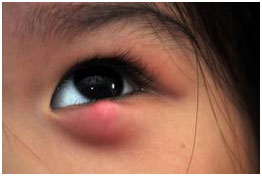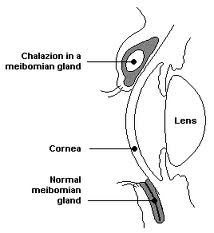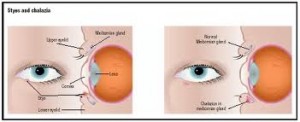A chalazion is generally a painless, slowly enlarging nodule on the eyelid formed by inflammation of the meibomian glands. It is basically a chronic granulomatous enlargement of the meibomian glands of the eye-lid.
 The meibomian glands in the eyelid serve the purpose of lubricating the margins of the eyelids, by producing a layer of tear.
The meibomian glands in the eyelid serve the purpose of lubricating the margins of the eyelids, by producing a layer of tear.
Due to acute or subacute inflammation of the eyelid, which may be due to a stye, there occurs an obstruction of the duct of the meibomian gland, leading to retention of the tears and swelling of the lid.
In most cases chalazion may appear after a stye. Chalazion is essentially a benign enlargement and not cancerous in nature.
Disease progression of a chalazion leads to a painless granuloma that may be disfiguring cosmetically.
Causes
With a diagnosis of Chalazion, it is important to consider whether there is an underlying condition causing the Chalazion.
There are other medical conditions that may possibly cause Chalazion. A chalazion is usually secondary to some local inflammation or local infection such as a stye. It may be due to a residual aggregation of inflammatory cells following an eyelid infection such as hordeola and preseptal cellulitis, or may develop from the retention of meibomian gland secretions.
Cases of recurrent chalazia are frequently due to chronic blepharitis or poor lid hygiene.
All of the above ultimately lead to inflammation of the meibomian gland and this causes blockage of the duct which drains the gland. Duct blockage causes chronic enlargement of the gland and this presents as chalazion.
Symptoms
Patients will present with one or many focal, hard, painless nodules in the upper or lower eyelid. They may report some enlargement over time, and there may be a history of a painful lid infection prior to the chalazion development, but this isn’t always the case. Chalazia are often recurrent, especially in cases of poor lid hygiene or concurrent blepharitis.
The size of the chalazion may vary form a tiny grain to a peanut size. The chronic chalazion tends to give a hard feel because of induration of the tissues. It may produce some pressure effects on the eye-lid.
Sensitivity to light and increased tearing may be noted in some cases.
Chalazia are more common in adults than in children.
Chalazia are usually associated with the following conditions:
Acne rosacea, chronic blepharitis and seborrhoea.
A large chalazion can cause astigmatism due to pressure on the cornea. This will resolve with resolution of the chalazion.






